26 GHz线性阵列源检测的分层波束形成策略
IF 1.5
4区 地球科学
Q3 ASTRONOMY & ASTROPHYSICS
引用次数: 0
摘要
本工作研究了毫米波通信系统的分层波束形成策略,重点是幅度递减和子阵列方法。该研究解决了对下一代无线网络至关重要的到达角(AoA)估计和波束管理方面的关键挑战。基于锥形的方法,在4元线性阵列上实现,展示了精确的波束宽度和旁瓣控制,在减少实现工作量的情况下实现分层搜索策略。实验验证了该方法在视距条件下识别传输方向的有效性;然而,它对全阵列激活的依赖使得它在反射环境中能效较低,对多路径引起的误差更敏感。相反,应用于8元线性阵列的子阵列方法显示出对多径效应的增强鲁棒性和可量化的功耗节省。通过在每个搜索级别只激活元素的子集,该方法可以使每个配置的平均功率降低42%,并且比穷举搜索显著减少波束评估。它的层次适应性支持能量需求平衡的高效AoA估计。专家k因子分析验证了其在视线主导环境中的适用性。对比结果表明,虽然变细可以获得高角度分辨率,但需要精确的幅度控制,并且对多径的弹性较差。子阵列技术虽然在旁瓣抑制方面效果较差,但具有优越的可扩展性、灵活性和能源效率,使其成为现实世界毫米波系统的实用选择。这项工作强调了分层码本设计在优化毫米波通信的波束形成性能、训练效率、执行时间和功耗方面的潜力。本文章由计算机程序翻译,如有差异,请以英文原文为准。
Hierarchical beamforming strategies for source detection with linear arrays at 26 GHz
The present work investigates hierarchical beamforming strategies for millimeter-wave communication systems, focusing on amplitude tapering and sub-array approaches. The research addresses key challenges in Angle of Arrival (AoA) estimation and beam management, essential for next-generation wireless networks. The tapering-based method, implemented on a 4-element linear array, demonstrated precise beamwidth and sidelobe control, enabling hierarchical search strategies with reduced implementation effort. Experimental validation confirmed its effectiveness in identifying transmission directions under line-of-sight conditions; however, its reliance on full-array activation made it less energy-efficient and more sensitive to multipath-induced errors in reflective environments. Conversely, the sub-array approach, applied to an 8-element linear array, showcased enhanced robustness against multipath effects and quantifiable power savings. By activating only a subset of elements at each search level, this method achieved an estimated 42% reduction in average power per configuration and significantly fewer beam evaluations than exhaustive search. Its hierarchical adaptability supported efficient AoA estimation with balanced energy demands. The Rician K-factor analysis validated its suitability for line-of-sight-dominated environments. Comparative results revealed that while tapering achieves high angular resolution, it requires precise amplitude control and is less resilient to multipath. The sub-array technique, though less effective in sidelobe suppression, offers superior scalability, flexibility, and energy efficiency, making it a practical choice for real-world millimeter-wave systems. This work highlights the potential of hierarchical codebook designs in optimizing beamforming performance, training efficiency, execution time, and power consumption for millimeter-wave communications.
求助全文
通过发布文献求助,成功后即可免费获取论文全文。
去求助
来源期刊

Radio Science
工程技术-地球化学与地球物理
CiteScore
3.30
自引率
12.50%
发文量
112
审稿时长
1 months
期刊介绍:
Radio Science (RDS) publishes original scientific contributions on radio-frequency electromagnetic-propagation and its applications. Contributions covering measurement, modelling, prediction and forecasting techniques pertinent to fields and waves - including antennas, signals and systems, the terrestrial and space environment and radio propagation problems in radio astronomy - are welcome. Contributions may address propagation through, interaction with, and remote sensing of structures, geophysical media, plasmas, and materials, as well as the application of radio frequency electromagnetic techniques to remote sensing of the Earth and other bodies in the solar system.
 求助内容:
求助内容: 应助结果提醒方式:
应助结果提醒方式:


